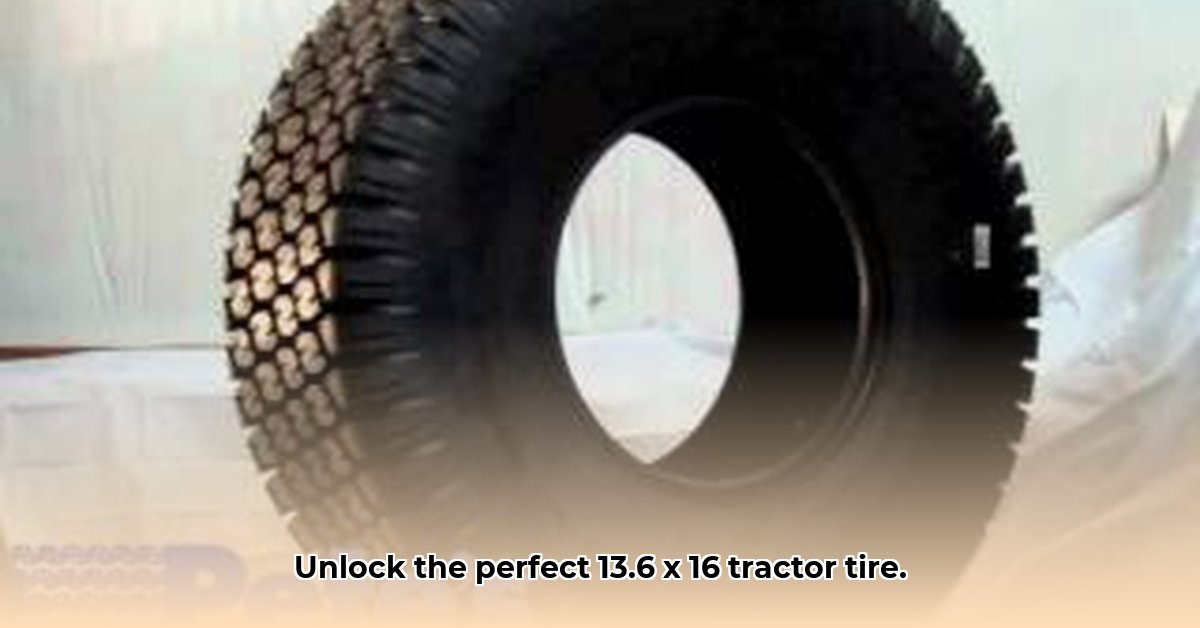
Choosing the right tires for your tractor significantly impacts efficiency, fuel consumption, and soil health. For smaller to medium-sized operations focused on landscaping or turf maintenance, the 13.6 x 16 tire is a common choice. However, navigating the market can be challenging due to inconsistent information from manufacturers and retailers. This guide helps you make an informed decision, even with limited readily available data. For more resources, check out this helpful guide on turf tractor tires.
Understanding the 13.6 x 16 Niche: Precision and Care for Your Land
The 13.6 x 16 tire isn't built for heavy-duty fieldwork. It's designed for tasks requiring precise control and minimal ground disturbance. Think meticulously manicured lawns, landscaping projects, or general work on surfaces where soil compaction needs to be minimized. These tires prioritize gentle traction over brute force. Unlike larger, heavier-duty tires, their focus is on precision and land care. Aren't you tired of damaging your precious turf every time you bring out the heavy machinery?
The Data Dilemma: The Need for Transparency in Tire Specifications
One major hurdle in selecting 13.6 x 16 tires is the inconsistent and often incomplete data provided by manufacturers and retailers. Direct comparisons are difficult due to this lack of standardization. This makes it challenging to evaluate key performance indicators (KPIs) and compare various tire options effectively. This lack of transparency is a significant problem for informed decision-making.
Key Performance Indicators (KPIs): What to Look For
Several key performance indicators (KPIs) directly affect a tire's performance and longevity. Understanding these KPIs is crucial for making the right choice.
Traction Coefficient: This measures how well the tire grips the ground, crucial for preventing slippage, especially on slopes or in wet conditions. A higher coefficient indicates better grip. Different soil types (clay, sandy loam, etc.) will significantly impact this coefficient.
Rolling Resistance: This indicates how much energy the tire loses as it rolls. Lower rolling resistance translates to better fuel efficiency and reduced operational costs. Think of it as the tire's "friction" – the less friction, the less fuel you burn.
Tire Lifespan: This refers to how long the tire lasts before needing replacement. While longevity is desirable, it should be balanced against other KPIs; a shorter-lived tire might offer superior traction or fuel efficiency.
Load Capacity: This is the maximum weight the tire can safely bear. Exceeding this limit can lead to tire failure, which is both dangerous and costly. Always ensure the load capacity adequately supports your tractor and any attached equipment.
Tread Depth: The depth of the grooves in the tire significantly impacts traction and lifespan. Deeper treads generally provide better grip, particularly in muddy or loose soil conditions, but may wear out faster.
| KPI | Importance | Considerations |
|---|---|---|
| Traction Coefficient | Crucial for preventing slips, maximizing power, and maintaining control. | Consider soil type (clay, sand, loam), working conditions (wet, dry), and slope gradients. |
| Rolling Resistance | Directly impacts fuel consumption, significantly reducing operational costs. | Lower rolling resistance translates to fuel savings and reduced environmental impact. |
| Tire Lifespan | A significant long-term cost factor; affects overall budget. | Balance longevity with other performance characteristics, considering the trade-offs involved. |
| Load Capacity | Crucial for safe operation; overloading tires is dangerous and can lead to failure. | Match or exceed the maximum weight your tractor and implements will exert on the tires. |
| Tread Depth | Influences traction and lifespan; deeper treads generally offer better grip. | Consider the balance between traction and wear rate; deeper treads may wear out faster. |
The Impact on Soil Health and Your Bottom Line
The long-term effects of tire choice extend beyond immediate operational efficiency. Poor traction leads to wasted fuel and increased wear and tear on your tractor. Excessive compaction from inappropriate tires can damage soil structure, affecting yields and sustainability. Choosing suitable 13.6 x 16 tires minimizes these negative effects, contributing to reduced operational costs and healthier soil. Isn't that a powerful ROI?
Your Buying Guide: Steps to a Smarter Decision
Thoroughly Examine Specifications: Don't rely solely on size; scrutinize manufacturer data sheets for detailed information on all KPIs.
Seek Independent User Reviews: Online reviews offer valuable real-world insights. Consider multiple reviews to obtain a balanced perspective.
Understand Your Work Environment: Identify the soil types you predominantly work with and your typical tasks. This helps prioritize the most relevant KPIs.
Calculate Total Cost of Ownership: Include initial price, fuel consumption, expected lifespan, and potential repairs when considering cost. A seemingly more expensive tire may prove more cost-effective in the long run.
Consult with Experts: Your local agricultural equipment supplier or mechanic can provide valuable tailored advice based on your specific needs and local conditions.
Remember: An informed decision about your 13.6 x 16 tractor tires benefits both your finances and the long-term health of your land. Advocate for better data from manufacturers; demand standardized testing for fairer comparisons. Your investment today impacts your operations for years to come.